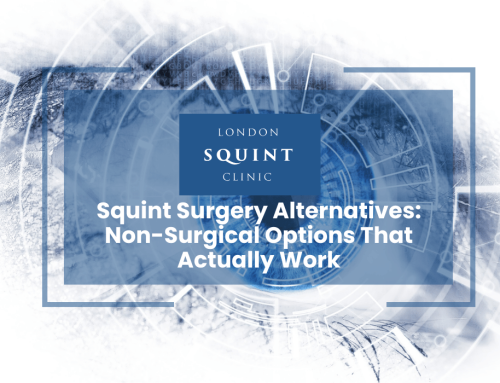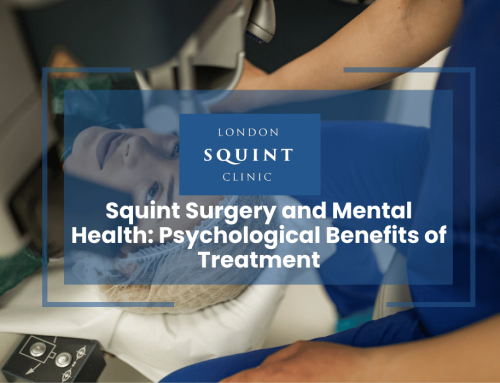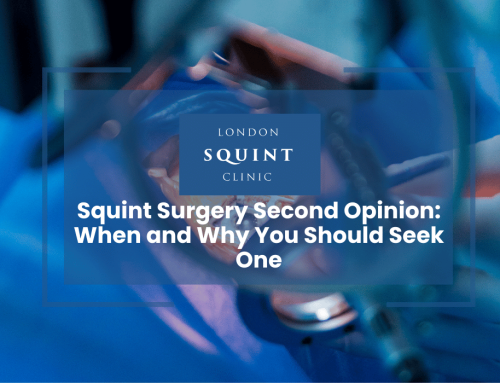Adult Squint Surgery London: Why 95% Success Rate Matters
Adult Squint Surgery London
- Adult squint affects approximately 4% of UK adults and can develop due to neurological conditions, trauma, or as a residual effect from childhood.
- Squint surgery is minimally invasive, typically performed as an outpatient procedure under local anesthesia with sedation, allowing for same-day return home.
- London offers world-class expertise with specialists who focus exclusively on squint treatment, performing hundreds of procedures annually.
- Recovery from squint surgery is generally well-tolerated with mild to moderate discomfort that subsides within days; most patients return to desk work within 1-2 weeks.
- The 95% success rate at London Squint Clinic reflects patients achieving their desired outcome after a single surgical procedure.
- Adult squint surgery differs from childhood procedures in goals, techniques, and anesthesia approaches, with adults often benefiting from adjustable suture techniques.
- Post-surgery benefits include resolution of double vision, enhanced depth perception, reduced eye strain, and significant psychological improvements.
- When selecting a surgeon, look for Fellowship of the Royal College of Ophthalmologists, subspecialty training in strabismus, and extensive experience with adult cases.
Table of Contents
- Understanding Adult Squint: Causes and Impact on Daily Life
- How Adult Squint Surgery Works: Procedure Explained
- Why Choose London for Your Squint Correction Surgery
- Is Squint Surgery Painful for Adults? Recovery Explained
- The 95% Success Rate: What This Means for Patients
- Adult vs. Childhood Squint Surgery: Key Differences
- Life After Squint Surgery: Vision Improvements to Expect
- Finding the Right Squint Surgeon in London: Qualifications
Understanding Adult Squint: Causes and Impact on Daily Life
Adult squint (strabismus) affects approximately 4% of adults in the UK, causing both functional and psychological challenges. Unlike the common misconception that squints only affect children, adult-onset strabismus can develop due to various factors including neurological conditions, trauma, or as a residual effect from childhood.
The primary causes of adult squint include:
- Cranial nerve palsies (particularly affecting the 3rd, 4th, and 6th nerves)
- Thyroid eye disease
- Stroke or brain injury
- Decompensation of a previously controlled childhood squint
- Age-related changes to eye muscles
- Complications from eye surgery
The impact on daily life can be profound. Many patients experience debilitating double vision (diplopia), which affects driving, reading, and work performance. The misalignment can cause eye strain, headaches, and difficulty with depth perception. Beyond these functional issues, the cosmetic aspect often leads to significant psychological distress, with many adults reporting reduced self-confidence, anxiety in social situations, and even career limitations.
Understanding that adult squint is a legitimate medical condition requiring expert intervention is crucial. With proper assessment and treatment at a specialised clinic, most adults can achieve significant improvement in both vision and appearance.
How Adult Squint Surgery Works: Procedure Explained
Adult squint surgery (strabismus surgery) is a precise procedure that adjusts the position of the eye muscles to improve alignment. At London Squint Clinic, this outpatient procedure typically takes 45-90 minutes depending on complexity and involves several carefully executed steps.
The surgical process begins with a comprehensive pre-operative assessment to determine exactly which muscles require adjustment. Using specialised instruments, the surgeon makes a small incision in the conjunctiva (the clear membrane covering the white of the eye) to access the eye muscles. No incisions are made on the visible external parts of the eye, meaning there are no visible scars post-surgery.
There are two primary surgical techniques employed:
- Recession: The muscle is detached and reattached further back on the eye to weaken its action
- Resection: A portion of the muscle is removed to shorten and strengthen its action
For adults, the procedure is typically performed under local anaesthesia with sedation, allowing for adjustable sutures in many cases. This technique enables the surgeon to fine-tune the eye position while the patient is awake, significantly improving precision and outcomes.
Modern microsurgical techniques have dramatically improved both the safety and efficacy of adult squint surgery. The procedure is minimally invasive, with self-dissolving stitches used to close the conjunctival incision. Most patients can return home the same day, making it a convenient option for busy professionals seeking correction of longstanding or recently developed squints.
Why Choose London for Your Squint Correction Surgery
London stands as a global centre of excellence for ophthalmological care, particularly for specialised procedures like adult squint correction. The capital offers distinct advantages that make it an optimal choice for patients seeking strabismus surgery.
Foremost among these advantages is access to world-class expertise. London houses some of the most experienced squint surgeons globally, many of whom have pioneered innovative techniques in strabismus correction. At London Squint Clinic, our specialists focus exclusively on squint and double vision treatment, performing hundreds of procedures annually—far more than general ophthalmologists who may only occasionally perform such surgeries.
The technological infrastructure in London’s specialist eye clinics is unparalleled, featuring advanced diagnostic equipment and surgical facilities specifically optimised for delicate eye muscle procedures. This technological edge translates to more precise assessments, less invasive surgeries, and ultimately better outcomes.
London’s position as a medical research hub means patients benefit from the latest evidence-based approaches. Many consultants actively contribute to international research, ensuring treatment protocols reflect the most current understanding of adult strabismus management.
For international patients, London offers exceptional accessibility with comprehensive care pathways designed to accommodate those travelling specifically for treatment. The city’s multicultural environment ensures patients from diverse backgrounds receive culturally sensitive care, often with multilingual support available.
While cost considerations are important, the value proposition of choosing London for squint correction extends beyond the procedure itself to encompass the entire patient journey, from initial consultation through to long-term follow-up care.
Is Squint Surgery Painful for Adults? Recovery Explained
Many prospective patients are concerned about pain during and after adult squint surgery. The good news is that modern techniques have significantly minimised discomfort throughout the entire process. During the procedure itself, patients experience no pain due to either general anaesthesia or local anaesthesia with sedation, depending on the specific case requirements.
Post-operative discomfort is typically mild to moderate and well-managed with standard pain relief medications. Most patients describe the sensation as grittiness or soreness rather than acute pain. The eyes may feel irritated and watery for several days, with some patients experiencing mild headaches as the visual system adjusts to the new eye alignment.
The recovery timeline for adult squint surgery generally follows this pattern:
- First 24-48 hours: Expect some redness, watering, and mild discomfort
- Days 3-7: Significant reduction in discomfort, though redness may persist
- Weeks 1-2: Most patients return to desk work and light activities
- Weeks 3-4: Resumption of normal activities including driving and exercise
- Months 1-3: Complete healing with stabilisation of the final eye position
Aftercare is straightforward but important. Patients are typically prescribed antibiotic and anti-inflammatory eye drops for the first week. Cold compresses can help reduce swelling, while avoiding eye rubbing is essential. Most patients can shower normally the day after surgery but should avoid swimming for at least two weeks.
At London Squint Clinic, we provide comprehensive aftercare instructions and 24/7 access to clinical support during the recovery period, ensuring any concerns are promptly addressed. Most patients are pleasantly surprised by how manageable the recovery process is, with minimal disruption to their daily lives.
The 95% Success Rate: What This Means for Patients
The 95% success rate achieved at London Squint Clinic for adult squint surgery represents a significant clinical benchmark that prospective patients should understand in context. This statistic reflects patients who achieve their desired outcome—whether that’s elimination of double vision, improved eye alignment, or both—after a single surgical procedure.
This success rate is particularly impressive considering that adult strabismus is often more complex than childhood cases. Adult eye muscles have established tension patterns over decades, making adjustment more challenging. Additionally, many of our patients have previously undergone unsuccessful surgeries elsewhere or present with complicated neurological factors.
What constitutes “success” in squint surgery is multidimensional:
- Functional success: Resolution of double vision and improved depth perception
- Cosmetic success: Improved eye alignment within 10 prism dioptres of perfect alignment
- Patient satisfaction: Meeting the individual’s expectations and improving quality of life
It’s important to note that this success rate is not achieved by chance but through meticulous pre-operative assessment, surgical planning, and the use of adjustable suture techniques where appropriate. The extensive experience of our surgical team—focusing exclusively on strabismus rather than general ophthalmology—contributes significantly to these outcomes.
For the approximately 5% of patients who don’t achieve their desired outcome with a single procedure, secondary adjustments are typically straightforward. These are usually minor revisions rather than complete re-operations, with excellent results achieved in the vast majority of these cases.
This exceptional success rate provides reassurance to adults who may have been told their squint is untreatable or who have lived with the condition for decades believing nothing could be done. At London Squint Clinic, even complex and longstanding cases have excellent prospects for improvement.
Adult vs. Childhood Squint Surgery: Key Differences
Adult squint surgery differs significantly from childhood procedures in several important aspects, reflecting the distinct physiological and psychological factors at play. Understanding these differences is crucial for adult patients considering surgical correction.
The primary distinction lies in the goals of treatment. While childhood squint surgery focuses heavily on preventing amblyopia (lazy eye) and developing normal binocular vision, adult procedures primarily aim to correct double vision, improve cosmetic appearance, and enhance existing visual function. The developmental window for establishing new binocular connections has typically closed in adulthood, though some adults do experience improved binocular function post-surgery.
Surgical techniques also differ substantially. Adults frequently benefit from adjustable suture techniques, where fine-tuning of eye position occurs after the patient is awake, allowing for more precise alignment. This approach is rarely used in children due to cooperation requirements. Additionally, adult surgery often involves more complex muscle adjustments to overcome decades of established muscle tension patterns.
Anaesthesia approaches vary as well. While children typically require general anaesthesia, many adult procedures can be performed under local anaesthesia with sedation, reducing recovery time and allowing for intraoperative adjustments. This difference in anaesthetic approach contributes to the outpatient nature of most adult procedures.
Recovery experiences differ markedly. Adults generally report less post-operative discomfort than anticipated but may experience more pronounced temporary diplopia (double vision) during the adaptation period as their brain adjusts to the new eye alignment. Children typically adapt more quickly neurologically but may require more support managing post-operative care.
Finally, the psychological dimension cannot be overlooked. Adults often bring years or decades of emotional burden related to their squint, making the psychological benefits of successful surgery particularly profound. The improvement in social confidence and professional interactions frequently represents as significant an outcome as the physical correction itself.
Life After Squint Surgery: Vision Improvements to Expect
Following adult squint surgery at London Squint Clinic, patients typically experience a transformative improvement in both visual function and quality of life. Understanding the realistic expectations for post-surgical outcomes helps patients prepare for their recovery journey.
For patients with pre-operative double vision (diplopia), the most immediate and dramatic benefit is usually the resolution or significant reduction of this symptom. Approximately 85% of patients with diplopia experience complete resolution within the first month after surgery. The remaining patients typically see substantial improvement, often with any residual double vision limited to specific gaze directions or eliminated with minor optical corrections.
Visual improvements extend beyond diplopia resolution. Many patients report:
- Enhanced depth perception and 3D vision
- Expanded visual field and peripheral awareness
- Reduced eye strain and fatigue during reading or screen use
- Improved spatial judgement for activities like driving or sports
- Elimination of compensatory head postures previously used to avoid double vision
The cosmetic improvement in eye alignment brings profound psychological benefits. Patients frequently report renewed confidence in social and professional interactions, comfort in making eye contact, and freedom from self-consciousness about their appearance. Many describe feeling as though they can finally present their “true self” to the world.
Adaptation to the new visual status occurs gradually. While some patients experience immediate improvement, others undergo a period of neural adaptation as the brain adjusts to the new eye alignment. During this period, which typically lasts 2-6 weeks, some patients may experience fluctuating vision or temporary diplopia in certain gaze positions.
Long-term stability of results is excellent in most cases. While approximately 10% of patients may experience some drift in alignment over time, this is usually minor and often doesn’t require further intervention. For those who do need adjustment, minor revision procedures typically achieve excellent results.
Finding the Right Squint Surgeon in London: Qualifications
Selecting the right squint surgeon in London is perhaps the most crucial decision in your treatment journey. Adult strabismus surgery requires specialised expertise beyond general ophthalmology, and the surgeon’s qualifications directly impact your outcome. Here’s what to look for when evaluating potential specialists.
First and foremost, verify that the surgeon holds Fellowship of the Royal College of Ophthalmologists (FRCOphth) and has completed subspecialty training in strabismus. The most qualified surgeons will have undertaken additional fellowship training specifically in complex strabismus management, often at institutions like Moorfields Eye Hospital.
Experience matters significantly in this subspecialty. Enquire about:
- The number of adult squint procedures performed annually (ideally 100+)
- Experience with your specific type of strabismus
- Familiarity with complex cases and revision surgeries
- Published success rates and complication statistics
Look for surgeons who focus predominantly or exclusively on strabismus rather than those who perform squint surgery as a small part of a general ophthalmology practice. Specialists who concentrate on this area typically achieve superior outcomes due to their depth of experience with the full spectrum of squint presentations.
Academic credentials can indicate expertise at the cutting edge of the field. Surgeons who publish research in peer-reviewed journals, speak at international conferences, or hold teaching positions typically remain current with the latest techniques and approaches.
Beyond technical qualifications, consider the surgeon’s communication style and approach to patient care. Adult squint correction involves understanding both functional and cosmetic goals, requiring a surgeon who listens carefully to your specific concerns and expectations.
At London Squint Clinic, our specialists meet all these criteria, with documented success rates exceeding 95% and thousands of procedures performed. We encourage prospective patients to ask detailed questions about qualifications during consultation, as this transparency forms the foundation of the trust essential to successful treatment.
Frequently Asked Questions
How long does adult squint surgery take?
Adult squint surgery typically takes between 45-90 minutes depending on the complexity of the case. The procedure is usually performed as an outpatient treatment, meaning you can go home the same day. More complex cases involving multiple muscles or revision surgery may take longer, but your surgeon will discuss the expected duration during your consultation.
What is the recovery time after adult squint surgery?
Recovery after adult squint surgery follows a general timeline: 24-48 hours for initial discomfort and redness, 1-2 weeks to return to desk work and light activities, 3-4 weeks to resume normal activities including driving, and 1-3 months for complete healing and stabilization of the final eye position. Most patients experience minimal disruption to their daily lives after the first week.
Can squint be corrected in adults without surgery?
Some adult squints can be managed non-surgically through prism glasses, specialized exercises, or Botox injections, particularly for small-angle deviations or temporary conditions. However, for permanent correction of significant misalignment, surgery remains the most effective treatment option. Non-surgical approaches are typically considered first for mild cases or when surgery is contraindicated.
Will I have double vision after squint surgery?
Temporary double vision is common in the first few days or weeks after squint surgery as your brain adapts to the new eye alignment. For most patients, this resolves completely within 2-6 weeks. Approximately 85% of patients with pre-operative double vision experience complete resolution within the first month after surgery, while others see substantial improvement with any residual double vision limited to specific gaze directions.
What are the risks of adult squint surgery?
The risks of adult squint surgery include under or overcorrection (5% of cases), infection (very rare at less than 1:1000), persistent double vision in certain gaze positions, and temporary redness or discomfort. Serious complications affecting vision are extremely rare. The vast majority of patients experience no significant complications, with the benefits far outweighing the risks for most adults with squint.
Is adult squint surgery covered by insurance?
Adult squint surgery is typically covered by private health insurance when medically necessary, particularly when the squint causes double vision or significant visual dysfunction. Coverage may vary between providers, with some requiring documentation that the procedure is functional rather than purely cosmetic. NHS funding is available for adult squint surgery when it meets clinical criteria, though waiting times may be longer than private treatment.
Find out if you are suitable for Double Vision Treatment
Not everyone is eligible for double vision surgery.
Find out if you could benefit from this life-changing surgery by taking the quick self-suitability quiz below:
Our most popular procedures

Hello, I’m Nadeem Ali
I’m one of the few eye surgeons in the world with 100% focus on Squint and Double Vision Surgery.
I have 24 years of eye surgery experience, and worked for 13 years as a Consultant at London’s renowned Moorfields Eye Hospital.
In 2023, I left the NHS to focus fully on treating patients from across the world at the London Squint Clinic. You can read more about me here.
There’s lots of information on the website about: squint surgery, double vision surgery and our pricing.
The most rewarding part of my job is hearing patients tell me how squint or double vision surgery has changed their lives. You can hear these stories here.
Mr Nadeem Ali
MA MB BChir MRCOphth FRCSEd(Ophth)





